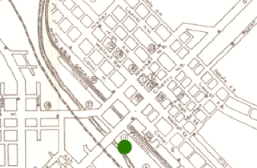Open (courtesy of Canal Fulton Canalway Center)
Season: Canalway Center season (May-Oct)
Days: Canalway Center days (Sun-Sat)
Hours: Canalway Center hours (10AM-4PM)
The St. Helena II: A Community Rises to the Challenge
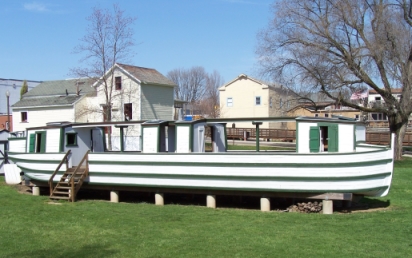
Throughout the 1960's, a number of factors spawned a revival of interest in the old Ohio & Erie Canal. The state of Ohio was in the process of divesting itself of its publicly owned canal lands and would give each county commissioners the option of acquiring these lands within their county. At this time, Stark County was fortunate to have Ralph Regula serving the community. Mr. Regula would be instrumental in the acquisition of the canal lands for the county.1 Regula and others would work throughout the following years on developing the canalway as a way to commemorate the historic water-route that meant so much to our state's forefathers.
Equally fortunate were we to have Mr. Al Simpson
working at the Canton Repository. Throughout the
1960's & 70's, Mr. Simpson would write a regular
column, called "Along the Towpath," wherein he
expressed his hopes and dreams of seeing Stark County
develop the canal into a regional tourist, recreational
and educational attraction. Among his dreams were to
![The inaugural ride of the St. Helena II - pictured: [left to right] Dave Richey (crewman), Ralph Regula, Scott Lehmen (crewman), Al Simpson, Caroll Gantz, Ed Harriman, Gervis Brady](19.2photo_inaugural.jpg) see passengers one day boarding a replica canal boat in
Canal Fulton which they could take to Crystal Springs where
another boat could take them to Massillon and then another
onto Navarre, and so on allowing
passengers to truly voyage into yester-year!2
While the full extent of Simpson's dreams would not come
to pass, the Louisville Sportsmen's Club, in 1967, rose to
the challenge of beginning to build the first authentic
canal era freighter in the country since the close of
the canals.3
Over the next few years, many other Stark
County residents would also adopt this cause as their own.4
see passengers one day boarding a replica canal boat in
Canal Fulton which they could take to Crystal Springs where
another boat could take them to Massillon and then another
onto Navarre, and so on allowing
passengers to truly voyage into yester-year!2
While the full extent of Simpson's dreams would not come
to pass, the Louisville Sportsmen's Club, in 1967, rose to
the challenge of beginning to build the first authentic
canal era freighter in the country since the close of
the canals.3
Over the next few years, many other Stark
County residents would also adopt this cause as their own.4
Make no mistake, this was a tremendous undertaking. Over the next three springs, summers, falls and winters; materials, supplies, equipment, boat design, building technique, man-power, a construction site and all the other logistics had to be worked out by a mostly volunteer work force. Remember, it had been more than a generation since anyone had built a boat like this and, unfortunately, enthusiasm is no substitute for experience. However, the effort was balanced out with young, hardworking go-getters as well as dedicated old timers who together possessed the ingenuity and know-how to accomplish just about anything. With ideas and people in motion, it wasn't long before the work was underway.
Legacy of the St. Helena
Let's jump backward in the story for just a moment.
During the canal days, boat designs saw a variety of
changes and adaptations throughout this short lived
era - from the all enclosed line boat, to the
2-cabin freighter to the 3-cabin style.5
Likewise, as various
canals wound their way across the country, regional
characteristics arose in each area distinguishing one
boat design in one part of the country from another
elsewhere.6
And while there was a certain amount of
commonality in construction technologies and
techniques each individual boat builder (even within
the same geographic region) would no doubt tinker
around with what they regarded as the best design.7
All of this is to say that without any architectural
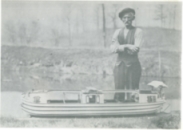 schematics to work from how would one build a boat
hull historic to this area? Photos of old canal boats
only show a portion of the exterior above the
waterline - so where could one go to obtain the
necessary schematics to build Stark County's new boat?
schematics to work from how would one build a boat
hull historic to this area? Photos of old canal boats
only show a portion of the exterior above the
waterline - so where could one go to obtain the
necessary schematics to build Stark County's new boat?
This was the question facing engineer Caroll Gantz. Having done his homework, Gantz was able to piece together a set of construction plans based on measurements extrapolated from studying photos of old canal boats. At this point in our story also enters the superb craftsmanship of William McLaughlin. In 1933, McLaughlin built (from memory) an incredibly detailed scale model of the St. Helena canal freightor (which had been registered in Newark in the late 1800's). Upon discovering this model at the McKinley Museum, Gantz was able to confirm and refine the dimensions needed for Canal Fulton's boat.8 While construction was underway and it came time to name the new vessel, among the suggestions (and ultimately the one that won) was the St. Helena II.9 There is no way that William could have known that his hobby would one day become an icon and legacy for both Canal Fulton and the whole of Stark County; yet, the St Helena III continues to keep this name afloat on the monumental waterway of the Ohio & Erie Canal.
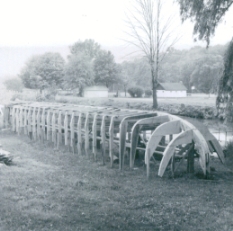
Construction
However, before any boat could "set sail" many, many preparations would need to be made. Lumber (white oak) donated by area farmers would need milled and cut into the appropriate pieces and of course a construction site and storage yard near the canal was a necessity. Even while the towpath itself had long been used by locals as a walking trail, the canal banks would need cleared of any obstructions to boat operations. Consideration was also needed to provide two locations within the 40' wide canal where this approximately 60' long vessel could turn around.* Teams of mules to provide the motive power would also need to be acquired. Certainly not the least among their needs was to drum up support and publicity so that when the boat would finally be made ready the whole project would prove worthwhile.10
Keel construction began in 1967 and by the end of that year, the rib frame-work of the hull was also laid. By the end of 1968 the hull was planked. By the close of 1969, the boat was caulked, painted, up-righted and decked. In early 1970, construction of the cabins would begin and by mid-summer these would be finished as would the docking hardware and capstan. Early June would see her maiden voyage - which proved to be a successful test drive. In mid-June, she would hold a press day and finally on July 11th, 1970 (during the Old Canal Days Festival) this monumental community achievement would be dedicated and begin her service to the public.11
Operations
At the end of her first season, the St. Helena II
would have given passage to 15,554 riders!12
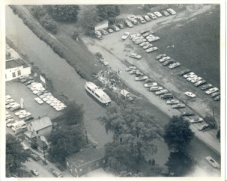 By 1974 the II would give ride to more than 100,000
passengers.13
The 200,000th rider would receive passage
in 1980.14
Clearly, this operation was a tremendous
draw to this little community! Indeed, because of the
outpouring of community support for these efforts,
the Stark County Historical Society entrusted this
operation to the Canal Fulton Heritage Society in
1975.15
Throughout the ensuing years, these boat
rides fulfilled a HUGE part of the Heritage Society's
mission. Canal Fulton's shores were once again busy
with traffic along this historic waterway.
By 1974 the II would give ride to more than 100,000
passengers.13
The 200,000th rider would receive passage
in 1980.14
Clearly, this operation was a tremendous
draw to this little community! Indeed, because of the
outpouring of community support for these efforts,
the Stark County Historical Society entrusted this
operation to the Canal Fulton Heritage Society in
1975.15
Throughout the ensuing years, these boat
rides fulfilled a HUGE part of the Heritage Society's
mission. Canal Fulton's shores were once again busy
with traffic along this historic waterway.

However, in 1984, the II, along with other deterioration, was diagnosed with a fatal "hog in the spine" - meaning the internal portions of the keel and ribs had warped beyond repair (more so than what new exterior planking along the hull could bind together).16 She would continue being patched up by her stalwart crew through the next several seasons yet the time would come when new planking and sealant just wouldn't be enough. In the meanwhile, she would host dinner parties, weddings, school outings, bus charters and would continue to be synonymous with Canal Fulton's historic tourism. When the grand old lady was finally laid to rest in 1988 she had given ride to more than a quarter of a million passengers.
Restoration
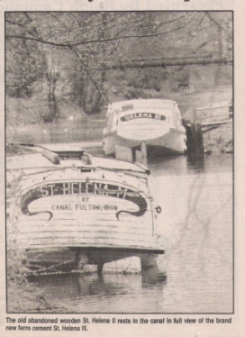
For the next several years (while her successor was
under construction) debates went back and forth as
to what would become of the II - would she be sold
to another town for a museum exhibit or would she
remain here with the dedicated folks who built and
operated her? In the meanwhile,
she languished in the canal until 1994 (a visage no
doubt akin to the end of the canal era - a mere 80
years before - when unused canal boats littered the
once great waterway). As the Heritage Society had
our hands full with building the
St. Helena III,
ownership of the II was given over to the City.
Maintenance efforts through the next several years
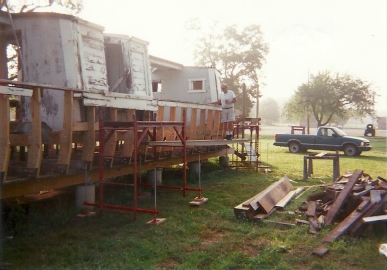 continued to be sporadic until John Hatfield (a Canal
Fulton Councilman at the time) spearheaded one last
push to restore this community landmark. Hefty
stanchions were constructed to support the
frame work of this 22 ton monument. Much of the
exterior planking needed replacing and the whole boat
was given a face-lift. While funds fell short of
furnishing the boat in a working 1800's
cargo-boat fashion, she nonetheless stands next to
our Museum displaying both our town's canal heritage
and memorializing the community's commitment to its
preservation.
continued to be sporadic until John Hatfield (a Canal
Fulton Councilman at the time) spearheaded one last
push to restore this community landmark. Hefty
stanchions were constructed to support the
frame work of this 22 ton monument. Much of the
exterior planking needed replacing and the whole boat
was given a face-lift. While funds fell short of
furnishing the boat in a working 1800's
cargo-boat fashion, she nonetheless stands next to
our Museum displaying both our town's canal heritage
and memorializing the community's commitment to its
preservation.
Carroll Gantz (the architect who designed the II) wrote a wonderful book Building the St. Helena II: Rebirth of a Nineteenth-Century Canal Boat - which can be purchased from our Museum Gift Shop.
John Harriman, son of Ed Harriman (who was a dedicated leader within the Canal Fulton community and important proponent of the St. Helena II), has also written a book [which was edited by Al Simpson] that showcases in brief the life of the St. Helena II - Sticking Together to Build the Canal Boat St. Helena II.
Both Carroll and John's books can be checked out from the Canal Fulton Public Library.
Web Page Notes
"St. Helena II A Dream Come True," The Canawler, 1970, Vol.3, No.2.
2. "Surely there must be organizations in Stark County that would enjoy building an authentic canal boat that could be used all summer to transport local residents and tourists from Canal Fulton and Massillon to Crystal Springs. I can see it now - the canal boat 'Massillon' pulling into Crystal Springs and discharging its passengers who then transfer to the 'Canal Fulton' for the remainder of the trip..."
Al Simpson, Along the Towpath: A Journalist Rediscovers the Ohio & Erie Canal, Russ Musarra, ed., (Akron, OH: The University of Akron Libraries, 2003), 21f. From his March 7, 1965 article 'Who will be the first to build canal boat? Navarre, Fulton or Massillon?'
Gantz, Building the II, 46.
"Dream Come True", The Canawler.
Gantz, Building the II, 43-5, 51.
"Dream Come True", The Canawler.
Woods, Glossary, 17, 24, 30.
Carroll Gantz made various comments regarding canal boat designs both how they differed regionally as well as uniqueness within boats of the same type in the same region.
Carroll Gantz, "Designing the St. Helena II," (Canal Society of Ohio) Towpaths Newsletter, Vol. 10, No. 2, 1974, 18-20.
7. Though, to be sure, boat dimensions would have been pretty consistant throughout the Ohio & Erie Canal in order to navigate the locks - which [with the exception of the terminal locks, that were slightly larger in order to accomodate the longer lake and river craft] were all 90' long and 15' wide.
...further footnote and reference forth coming...
Charles McLaughlin recalled of the family boat building: "Dad [Edward] and his brother [William]...He had some plans, but mostly it was by knowledge and by testing."
Woods, Interview with Charles McLaughlin, 1974, CFHS Collections.
Gantz, Building the II, 49, 52-5, 57.
The model had been donated to the Stark County Historical Society by a widow of one of Williams descendants some time before Gantz discovered it.
"A Brief History," The Canawler, Summer 1967.
9. Among the 150 suggested boat names, designer Carrol Gantz and Mrs. W.F. Cassidy submitted the winning nomination - though the judges wouldn't know who the nominations came from until after the vote was decided. Many of the naming suggestions were based on other canal boats or persons of notoriety during the O & E Canal days; some were derivations of 'Fulton' [e.g. Fulton Belle, Fultonaire, Canal Fultonnire]; in the tradition of still other canal boat names of yore many were quite whimsical [e.g. Fulton's Folly, Slow But Sure, OH-HI-OH].
Boat Naming Committee, Canal Branch Board of Managers, Stark County Historical Society Meeting Minutes, Meeting 11 March 1970, CFHS collections.
10.
Rotary Club pontoon boat rides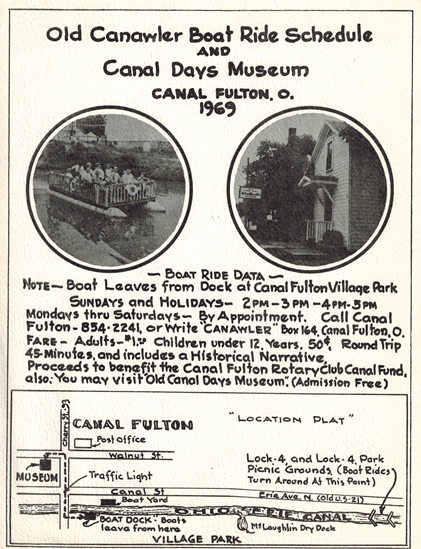 would help incite some enthusiasm for the upcoming canal boat rides.
would help incite some enthusiasm for the upcoming canal boat rides.
Canal Fulton Rotary Club, Pontoon Boat Ride flyer, 1969, CFHS collections.
11.
A special ride was held for dignitaries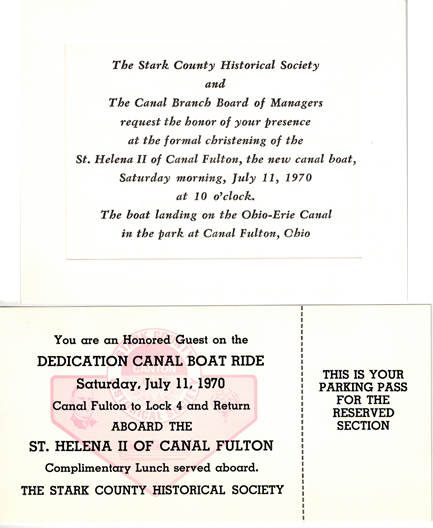 and afterward rides would be available to the public.
and afterward rides would be available to the public.
Gantz, Building the II, 62-97.
St. Helena II Dedication Invitation and Ticket, Canal Branch Board of Managers, Stark County Historical Society, 1970, CFHS collections.
12. And she carried 29,385 passengers through her second season in 1971.
Clyde Gainey, "Who'da Ever Thought It," The Canawler, 1971, Vol.4 No.2.
13. The lucky couple [the husband unknowingly buying the winning ticket for his wife] on Aug 22, 1974 recieved a refund of thier tickets, champagne and other souvenirs.
"St. Helena II boasts 100,000 passengers" The (Canal Fulton) Signal, 28 August 1974, 1.
Kevin Moriarty, "100,000 passenger on St. Helena receives gifts, bottle of champagne" The Massillon Evening Independent, 23 August 1974, 2.
...further footnote and reference forth coming...
15. The Stark County Historical Society, on April 1, 1975 transfered title to the St. Helena II to the Canal Fulton Heritage Society along with its properties at Lock 4 and lease of the dry dock land.
Transfer of Assests Agreement, Stark County Historical Society to Canal Fulton Heritage Society, March 1975, CFHS records.
16. Various repairs and maintenance techniques were suggested for getting the boat through the next several years but ultimatly the conclusion was made that the worn out keel and hull were so damaged that replacing the boat was the more expedient solution.
Report from John Scully to Canal Fulton Heritage Society, 29 November 1984, CHFS records.
"St. Helena diagnosed as terminal by expert" The (Canal Fulton) Signal, 26 November 1984.


